1. Tomatoes began to cultivate the ancient Aztecs and Incas at the beginning of the eighth century AD, but they first came to Europe only in the middle of the sixteenth century. 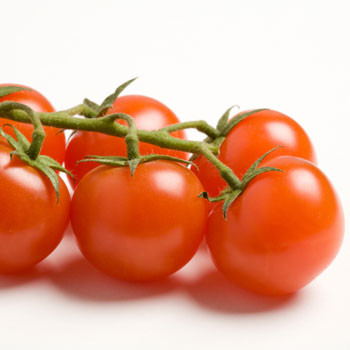 Tomatoes useful properties
Tomatoes useful properties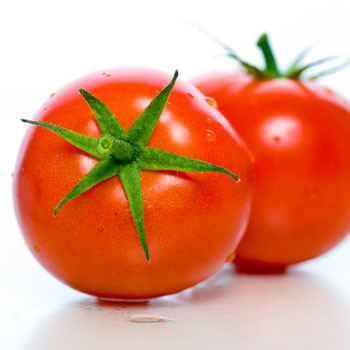 2 The Aztecs called this fruit “matle”, the French altered the name in their own way, having received the familiar “tomato” for everyone. The name “tomato”, in turn, comes from Italian and means “golden apple”. However, the Italians are not the only ones who compared a tomato to an apple: the French also called it “the apple of love”, and the Germans - “paradise apple” .3. In Russia, tomatoes (as well as potatoes) were treated with caution, calling them “rabid berries” or “psinki”. There was even a belief, according to which it was believed that whoever tasted these fruits, would certainly lose his mind. The recipe is available when you click on the name of the dish:
2 The Aztecs called this fruit “matle”, the French altered the name in their own way, having received the familiar “tomato” for everyone. The name “tomato”, in turn, comes from Italian and means “golden apple”. However, the Italians are not the only ones who compared a tomato to an apple: the French also called it “the apple of love”, and the Germans - “paradise apple” .3. In Russia, tomatoes (as well as potatoes) were treated with caution, calling them “rabid berries” or “psinki”. There was even a belief, according to which it was believed that whoever tasted these fruits, would certainly lose his mind. The recipe is available when you click on the name of the dish: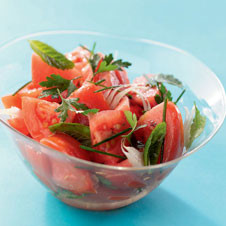 Herbs Tomatoes
Herbs Tomatoes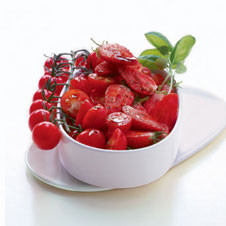 Salad of strawberries and cherry tomatoes
Salad of strawberries and cherry tomatoes Tomato salad4. The biological affiliation of tomato fruits is a complicated affair. In terms of botany, a tomato is a berry. In 1893, the US Supreme Court decided to consider tomatoes as vegetables, which, however, can also be found economically motivated: unlike fruits, the import of vegetables was subject to customs duties. The judge who made the decision concluded: “From a botanical point of view, a tomato, like cucumbers and beans, is a fruit or berry, as it grows on a vine and grows from a seed. But in the usual understanding of consumers, the above fruits are vegetables, as they grow in the gardens of the citizens and are consumed raw like potatoes and cabbage. And also due to the fact that they are usually eaten for lunch after the soup along with meat and fish and do not serve as a dessert, which distinguishes them from fruit. ” In 2001, the European Union restored historical justice, at least in the Old World, by ordering to consider tomato a fruit. However, in everyday life a tomato is still most often considered a vegetable. Every year the world produces more than 60 million tons of tomatoes, which is 16 million more than the production of bananas. The third place is occupied by apples, followed by oranges and melons. Most tomatoes are grown in China - 16% of the global production. There are at least 10,000 varieties of tomatoes in the world. The smallest tomato is less than 2 centimeters in diameter, and the largest reaches a weight of almost 1.5 kilograms.7. There are opposing views about the benefits and harm of tomatoes to human health:
Tomato salad4. The biological affiliation of tomato fruits is a complicated affair. In terms of botany, a tomato is a berry. In 1893, the US Supreme Court decided to consider tomatoes as vegetables, which, however, can also be found economically motivated: unlike fruits, the import of vegetables was subject to customs duties. The judge who made the decision concluded: “From a botanical point of view, a tomato, like cucumbers and beans, is a fruit or berry, as it grows on a vine and grows from a seed. But in the usual understanding of consumers, the above fruits are vegetables, as they grow in the gardens of the citizens and are consumed raw like potatoes and cabbage. And also due to the fact that they are usually eaten for lunch after the soup along with meat and fish and do not serve as a dessert, which distinguishes them from fruit. ” In 2001, the European Union restored historical justice, at least in the Old World, by ordering to consider tomato a fruit. However, in everyday life a tomato is still most often considered a vegetable. Every year the world produces more than 60 million tons of tomatoes, which is 16 million more than the production of bananas. The third place is occupied by apples, followed by oranges and melons. Most tomatoes are grown in China - 16% of the global production. There are at least 10,000 varieties of tomatoes in the world. The smallest tomato is less than 2 centimeters in diameter, and the largest reaches a weight of almost 1.5 kilograms.7. There are opposing views about the benefits and harm of tomatoes to human health:
- For example, it is believed that fruits containa large amount of oxalic acid, which is not absorbed by the body, binds calcium, forming insoluble oxalate compounds with it. The latter, in turn, are deposited in the kidneys in the form of stones. For comparison: the content of oxalic acid in ripe tomatoes does not exceed 5 mg per 100 g, while in potatoes it is not less than 40 mg, and - 360 mg.
- Fresh tomatoes, on the other hand, are the perfect food.in order to compensate for the loss of minerals. They contain potassium, magnesium, iron, zinc, calcium and phosphorus. And yet - quite a lot of vitamins - B1, B2, B3, B6, B9, E, but most of them are vitamin C.
eight.Tomatoes contain a lot of lycopene: this organic compound is a very strong natural antioxidant (superior in its properties to such recognized "free radical scavengers" as vitamins C and E). Eating Lycopene Prevents Cancer And Cardiovascular Disease! To get the most out of the tomato salad, season it with sunflower oil, because in combination with vegetable fats, lycopene is absorbed much better. The recipe is available by clicking on the name of the dish: Salad of roasted tomatoes, zucchini, labnech cheese and mint
Salad of roasted tomatoes, zucchini, labnech cheese and mint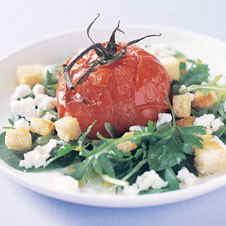 Poached Tomatoes with Goat Cheese
Poached Tomatoes with Goat Cheese Pie with tomatoes and caramelized onions9. Another very useful property of tomatoes is low calorie (22 kcal per 100 g). And chromium which is a part of tomatoes promotes the fastest saturation and prevents attacks of "brutal" hunger. Remember that the “dosage” should be limited to those who suffer from allergies to red vegetables and fruits. Tomatoes, like all vegetables of the nightshade family (potatoes, eggplants, sweet peppers), are rich in nicotinic acid. If a sufficient amount of it enters the human body, then he simply does not want to smoke. Therefore, those who want to get rid of nicotine addiction can be advised to stock up on "anti-tobacco" vegetables, including tomatoes. There are more nutrients in tomatoes of red varieties than in representatives of yellow varieties.12. Tomatoes retain all the beneficial properties after heat treatment. Moreover, it is believed that they become even more useful in sauces or in vegetable stews. They are well tolerated and canned - 68% of cooks prefer to use canned tomatoes, not only because of convenience, but also due to a more intense flavor. In addition, nutrients are absorbed from such tomatoes much better: half a glass of canned tomatoes is delivered to the body 3 times more lycopene than one fresh tomato.13. Over 100 methods of cooking and consumption of tomatoes are known: fresh, boiled, canned, fried, stuffed, in salads, vinaigrettes, soups, salted, pickled and even dried. 14. Low temperatures adversely affect tomatoes, so if possible try to avoid storing tomatoes in the refrigerator. A good tomato should be fleshy, with a smooth skin without dents and damage, bright red or red-orange. Unripe tomatoes ripen quickly if each of them is wrapped in a sheet of newspaper and left at room temperature.
Pie with tomatoes and caramelized onions9. Another very useful property of tomatoes is low calorie (22 kcal per 100 g). And chromium which is a part of tomatoes promotes the fastest saturation and prevents attacks of "brutal" hunger. Remember that the “dosage” should be limited to those who suffer from allergies to red vegetables and fruits. Tomatoes, like all vegetables of the nightshade family (potatoes, eggplants, sweet peppers), are rich in nicotinic acid. If a sufficient amount of it enters the human body, then he simply does not want to smoke. Therefore, those who want to get rid of nicotine addiction can be advised to stock up on "anti-tobacco" vegetables, including tomatoes. There are more nutrients in tomatoes of red varieties than in representatives of yellow varieties.12. Tomatoes retain all the beneficial properties after heat treatment. Moreover, it is believed that they become even more useful in sauces or in vegetable stews. They are well tolerated and canned - 68% of cooks prefer to use canned tomatoes, not only because of convenience, but also due to a more intense flavor. In addition, nutrients are absorbed from such tomatoes much better: half a glass of canned tomatoes is delivered to the body 3 times more lycopene than one fresh tomato.13. Over 100 methods of cooking and consumption of tomatoes are known: fresh, boiled, canned, fried, stuffed, in salads, vinaigrettes, soups, salted, pickled and even dried. 14. Low temperatures adversely affect tomatoes, so if possible try to avoid storing tomatoes in the refrigerator. A good tomato should be fleshy, with a smooth skin without dents and damage, bright red or red-orange. Unripe tomatoes ripen quickly if each of them is wrapped in a sheet of newspaper and left at room temperature.









